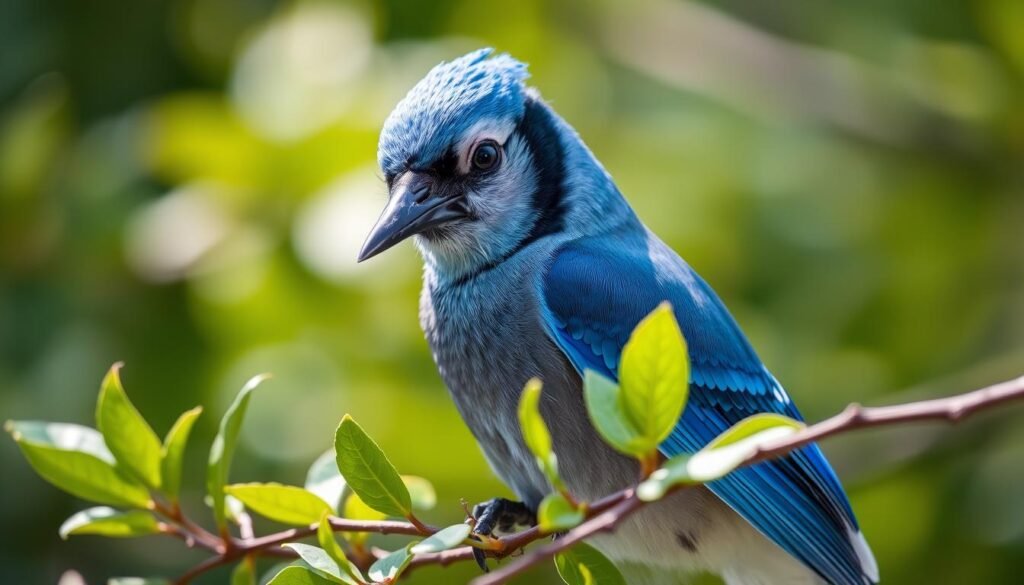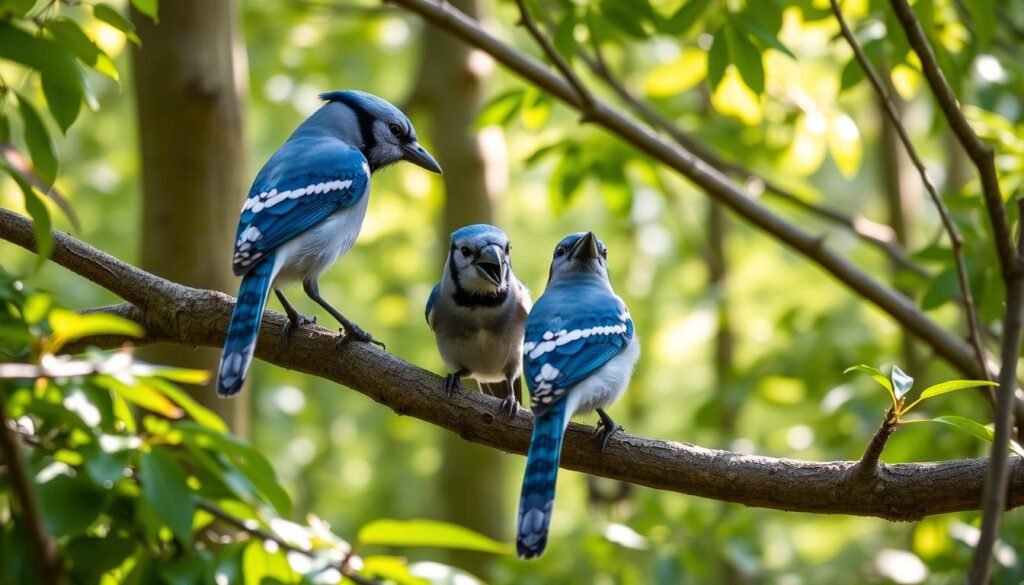The blue jay is a captivating bird found in North America. They are known for their bright colors, including deep blue, white, and black. Their unique crest and loud calls make them easy to spot and loved by many.
Blue jays are smart and adaptable, belonging to the corvid family. They are important in their ecosystems, helping to clean up and protect their territory. This article will explore their scientific details, habitat, behavior, and cultural significance.
Key Takeaways
- The blue jay is a vibrant and iconic bird species found throughout North America.
- They are known for their striking blue, white, and black plumage, as well as their distinct crest and bold calls.
- Blue jays are highly intelligent members of the corvid family, known for their adaptability and ability to thrive in various environments.
- These birds play a vital role in their ecosystems, serving as both scavengers and protectors of their territory.
- Blue jays hold symbolic meaning in many cultures, representing qualities such as intelligence, strength, and resilience.
Introducing the Stunning Blue Jay Bird
The blue jay is a captivating bird that graces North America’s landscapes. It is known for its brilliant blue jay color. This makes it one of the most recognizable birds in the region.
The Blue Jay’s Unmistakable Appearance
The blue jay’s plumage is a stunning mix of vibrant blues and a white chest. It also has a black necklace-like pattern. Its impressive crest, which it can raise and lower, adds to its regal look.
A Vibrant Splash of Color in Nature
The blue jay female coloration is truly captivating. Whether perched or in flight, its brilliant hues grab everyone’s attention. It’s a true standout in nature.
“The blue jay is a true marvel of nature, a feathered gem that adds a splash of vivid color to the world around us.”
The blue jay’s striking appearance and charismatic presence make it beloved. Its distinctive features and vibrant palette make it a natural wonder.
Blue Jay Bird: Scientific Name and Classification
The blue jay, known scientifically as Cyanocitta cristata, belongs to the Corvidae family. This family includes smart birds like crows and magpies. Knowing its scientific name helps us understand its unique traits and behaviors.
The name Cyanocitta cristata tells us a lot about the blue jay. The genus Cyanocitta points to its bright blue color. The species name cristata refers to its crest-like feathers. These feathers can change based on the bird’s mood or situation.
- The blue jay is classified as a member of the Corvidae family, which is known for its highly intelligent and adaptable birds.
- Within the Corvidae family, the blue jay is part of the genus Cyanocitta, which includes several species of jays found in North America.
- The blue jay’s scientific name, Cyanocitta cristata, highlights its unique physical features and distinguishes it from other members of the Corvidae family.
Knowing the blue jay’s scientific name and classification gives us insights into its evolution, adaptations, and role in the bird world.

Blue Jay Bird: A Fascinating Member of the Corvid Family
Blue jays are smart and flexible birds. They belong to the Corvid family. Their cleverness and unique behaviors make them interesting to birdwatchers and nature lovers.
Intelligence and Behavior of Blue Jays
Blue jays are part of the Corvid family, which includes crows and ravens. They are known for solving problems and remembering things well. They use tools, hide food, and even mimic other birds’ calls.
These skills, along with their bright colors and bold nature, make blue jays amazing. They are a true wonder of the bird world.
“Blue jays are not only beautiful, but they are also highly intelligent birds that can solve complex problems and adapt to various environments.”
Blue jays are also known for their social behavior. They form strong family bonds and work together. They defend their territory and take care of their young.
Their sounds, from loud calls to soft chirps, help them communicate. They use these sounds to warn other birds of danger.

Blue jays are not found in Europe. They mostly live in North America. But, they are known for being aggressive and territorial. Some blue jays even attack humans who get too close to their nests.
The Blue Jay’s Habitat and Range
The blue jay is found in a wide area, from the eastern and central U.S. to Canada. They live in many places, like forests, cities, and suburbs. Their ability to live in different places and their bright colors make them a favorite among bird lovers.
Preferred Environments and Nesting Habits
Blue jays love forests because they have everything they need. They build their nests high in trees using twigs and grass. They also like areas with open spaces and lots of plants, where they can find food and shelter.
| Habitat Type | Suitability for Blue Jays |
|---|---|
| Deciduous Forests | Excellent |
| Mixed Forests | Excellent |
| Urban Areas | Good |
| Suburban Neighborhoods | Good |
Blue jays are very good at living in different places. They can be found in forests and cities. Their bright colors and lively nature make them a joy to see in nature.

What Do Blue Jays Eat?
Blue jays eat a wide variety of foods. They are smart birds that find food in many ways. They enjoy seeds, nuts, fruits, insects, and even small animals.
Acorns and nuts are a big part of their diet. They can crack open hard shells to get to the good stuff inside. They also like seeds from sunflowers, corn, and berries.
- Nuts and seeds
- Fruits and berries
- Insects and other invertebrates
- Small vertebrates (such as small rodents or nestlings)
Blue jays also hunt for food. They catch insects, spiders, and sometimes small lizards or birds’ babies. This helps them live well in many places, from cities to forests.
| Food Type | Percentage of Diet |
|---|---|
| Nuts and seeds | 55% |
| Fruits and berries | 25% |
| Insects and other invertebrates | 15% |
| Small vertebrates | 5% |
Blue jays eat many different foods. This helps them survive in different places. Their smart way of finding food makes them interesting and successful birds.
Identifying Birds That Look Like Blue Jays
Blue jays are known for their bright colors, but some birds look similar. Knowing how to tell them apart can help you spot blue jays in your area.
Distinguishing Features of Similar Species
The Steller’s jay is often mistaken for a blue jay. But Steller’s jays have darker, more even blue feathers. Their crest is bigger and more noticeable than a blue jay’s. They live in the western U.S. and Canada, not where blue jays are common.
The Florida scrub jay also looks like a blue jay. It’s found in central Florida and has lighter blue feathers. It doesn’t have the white and black patterns on its wings and tail like a blue jay does.
- Steller’s jay: Darker, more uniform blue plumage; larger, more prominent crest; found in the western United States and Canada
- Florida scrub jay: Lighter blue coloration; more subdued crest; found only in central Florida
By paying attention to these differences, you can easily tell if you see a blue jay in your backyard or park.
The Aggressive Nature of Blue Jays
Blue jays are known for their territorial and aggressive behavior. They fiercely defend their nesting sites and food sources. This makes them interesting to birdwatchers and naturalists.
Territorial Behavior of Blue Jays
Blue jays are very territorial. They guard their nesting areas and food from rivals. They use loud calls and physical confrontations to keep intruders away.
During breeding season, their aggression increases. They protect their young and ensure their survival. They even dive-bomb and harass larger birds like hawks and owls near their nests.
| Behavior | Description |
|---|---|
| Territorial Defense | Blue jays will aggressively defend their nesting sites and food sources from other birds, often engaging in loud calls and physical confrontations. |
| Nest Protection | During the breeding season, blue jays are particularly protective of their nests and young, and will dive-bomb and harass larger birds that come too close. |
| Food Competition | Blue jays will fiercely compete with other birds for access to food sources, especially during times of scarcity. |
While their aggression can be a problem, it’s key to their survival. It shows their intelligence and adaptability. Understanding their territorial behavior helps us see their importance in the ecosystem.
The Symbolism and Meanings Behind Blue Jay Sightings
Blue jays hold a special place in many Native American cultures. They symbolize intelligence, adaptability, and the importance of protecting family and resources.
Seeing a blue jay might mean you need to stand up for yourself or your loved ones. These birds are bold and assertive. They inspire us to be more confident and courageous.
Blue jays are also fascinating creatures. Their bright blue feathers and crest make them stand out. What is special about a blue jay? Their intelligence and resourcefulness are truly noteworthy.
So, what does it mean if you see a blue jay? It’s a reminder to stay true to yourself. Protect what’s important and embrace your unique strengths – just like these remarkable birds.
“The blue jay, with his crest raised, is a sight to behold. He is a symbol of strength, resilience, and the importance of family.”
Encountering a blue jay can capture our attention and spark our imagination. Their presence reminds us to live with purpose, courage, and appreciation for nature.
Conclusion
The blue jay is a truly remarkable bird. It captivates observers with its striking appearance, intelligence, and unique behaviors. By learning about its scientific classification, habitat, diet, and cultural significance, we can appreciate its vital role in nature.
Its vibrant blue plumage and impressive problem-solving skills make it a wonder of nature. As a member of the Corvid family, it shows intelligence that fascinates many. Whether in North America’s forests or our backyard feeders, the blue jay reminds us of nature’s diversity and resilience.
This species plays a crucial role in the ecosystem. It disperses seeds and acts as a vocal sentinel, warning other birds of threats. By understanding and appreciating the blue jay, we can protect and conserve it. This ensures its beauty and wonder will be enjoyed for generations to come.
FAQ
What is the scientific name of the blue jay?
The blue jay’s scientific name is Cyanocitta cristata.
What family does the blue jay belong to?
The blue jay belongs to the Corvidae family. This family includes smart birds like crows and magpies.
Where can blue jays be found?
Blue jays live in the eastern and central United States, and parts of Canada. They like many places, like forests, cities, and suburbs.
What do blue jays eat?
Blue jays eat many things like seeds, nuts, fruits, insects, and small animals. They are good at finding food in different places.
Are blue jays considered aggressive birds?
Yes, blue jays can be very aggressive. They defend their homes and food from others, including humans.
What is special about the blue jay?
Blue jays are important in many Native American cultures. Seeing them is thought to mean they are smart, adaptable, and care about family and resources.
Are there blue jays in Europe?
No, blue jays live in North America, not Europe. They are found in the eastern and central United States and parts of Canada.
What does it mean if you see a blue jay?
Seeing a blue jay is usually a good sign. It means they are smart, adaptable, and care about family and resources. Their bright colors also bring joy and wonder.

